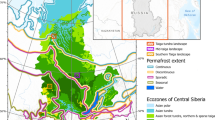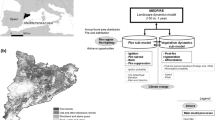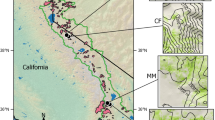Abstract
Context
In interior Alaska, increasing wildfire activity associated with climate change is projected to continue, potentially altering regional forest composition. Conifers are emblematic of boreal forest; however, greater frequency and severity of wildfires has been found to favor broadleaf-deciduous species in numerous studies.
Objectives
This study examines potential shifts in forest type in interior Alaska and how shifts may be impacted by recurring wildfires under future climate change.
Methods
A spatially-explicit forest landscape model, LANDIS-II, was used to simulate forest succession and wildfire over a 380,400-hectare landscape under historic and future (RCP 8.5) climate. Wildfire was modeled using the SCRPPLE fire extension and vegetation growth, belowground carbon, hydrologic, and permafrost dynamics were modeled with the DGS succession extension. The relative importance of drivers of forest type change away from black spruce was quantified using random forest models for areas on the landscape experiencing different numbers of wildfires.
Results
Greater frequencies of fire activity were associated with shifts in conifer-dominant areas to broadleaf-deciduous, which climate change accelerated. Vegetation transitions were most strongly influenced by percent tree mortality from the most recent wildfire. Starting deciduous fraction and proximity of mature black spruce to a site pre-fire were also influential, indicating pre-fire composition and context modified the effect of vegetation shifts.
Conclusions
These results underscore how shifts in forest type may occur in a nonlinear manner in this region as the landscape experiences pressure from climate change and forests are subject to complex interactions between wildfire, climate, belowground processes, and the arrangement of forest communities.






Similar content being viewed by others
Data availability
The datasets used to develop model inputs are cited within the manuscript and are available in the public domain. DGS model inputs for this study are available in the LANDIS-II-Foundation repository at: https://github.com/LANDIS-II-Foundation/Project-Alaska-Reburns.
References
Abramoff RZ, Davidson EA, Finzi AC (2017) A parsimonious modular approach to building a mechanistic belowground carbon and nitrogen model. J Geophys Res Biogeosci 122:2418–2434.
Alaska Center for Conservation Science (2017) Alaska vegetation and wetland composite map. https://accscatalog.uaa.alaska.edu/dataset/alaska-vegetation-and-wetland-composite. Accessed 17 Jan 2022
Begét JE, Stone D, Verbyla DL (2006) Regional overview of interior Alaska. Alaska’s changing boreal forest. Oxford University Press, New York, pp 12–20
Berner LT, Alexander HD, Loranty MM et al (2015) Biomass allometry for alder, dwarf birch, and willow in boreal forest and tundra ecosystems of far northeastern Siberia and north-central Alaska. For Ecol Manage 337:110–118.
Bieniek PA, Bhatt US, Walsh JE et al (2016) Dynamical downscaling of ERA-interim temperature and precipitation for Alaska. J Appl Meteorol Climatol 55:635–654.
Boby LA, Schuur EAG, Mack MC et al (2010) Quantifying fire severity, carbon, and nitrogen emissions in Alaska’ s boreal forest. Ecol Appl 20:1633–1647
Bryant JP, Joly K, Chapin FS et al (2014) Can antibrowsing defense regulate the spread of woody vegetation in arctic tundra? Ecography 37:204–211.
Buma B, Brown CD, Donato DC et al (2013) The impacts of changing disturbance regimes on serotinous plant populations and communities. Bioscience 63:866–876
Bunn AG, Goetz SJ (2006) Trends in satellite-observed circumpolar photosynthetic activity from 1982 to 2003: the influence of seasonality, cover type, and vegetation density. Earth Interact 10:1–19.
Burns RM, Honkala BH (1990) Silvics of North America: 1. Conifers; 2. Hardwoods. Agriculture Handbook 654. US Department of Agriculture, Forest Service, Washington, DC
Carmean WH, Hahn JT, Jacobs RD (1989) Site index curves for forest tree species in the eastern United States. General technical report NC-128. St Paul, MN: US Dept of Agriculture, Forest Service, North Central Forest Experiment Station. 142 p
Chapin FS, Callaghan TV, Bergeron Y et al (2004) Global change and the boreal forest: thresholds, shifting states or gradual change? Ambio 33:361–365.
Christie KS, Bryant JP, Gough L et al (2015) The role of vertebrate herbivores in regulating shrub expansion in the Arctic: a synthesis. Bioscience 65:1123–1133.
Fisher JP, Estop-Aragonés C, Thierry A et al (2016) The influence of vegetation and soil characteristics on active-layer thickness of permafrost soils in boreal forest. Glob Chang Biol 22:3127–3140.
Flannigan M, Stocks B, Turetsky M, Wotton M (2009) Impacts of climate change on fire activity and fire management in the circumboreal forest. Glob Chang Biol 15:549–560.
Flerchinger GN (2000) The simultaneous heat and water (SHAW) model: technical documentation. Technical Report NWRC 2000-09. Boise, ID: USDA Agricultural Research Service, Northwest Watershed Research Center. 37 p. URL https://www.ars.usda.gov/ARSUserFiles/20520000/shawdocumentation.pdf
Forbes BC, Fauria MM, Zetterberg P (2010) Russian Arctic warming and “greening” are closely tracked by tundra shrub willows. Glob Chang Biol 16:1542–1554.
Foster AC, Armstrong AH, Shuman JK et al (2019) Importance of tree- and species-level interactions with wildfire, climate, and soils in interior Alaska: implications for forest change under a warming climate. Ecol Modell 409:108765.
FRAMES (2023) Alaska Large Fire Database. URL https://www.frames.gov/catalog/10465. Accessed 2019
Frank P (2020) Herbivory moderates the positive effect of climate warming on shrub growth in Northern Interior Alaska [Unpublished master’s thesis]. Norwegian University of Science and Technology, Trondheim, Norway
GeoMAC (2019) Historic perimeters combined 2000–2018. U.S. geological survey. Accessed 14 Aug 2020
GeoMAC (2020) Historic Perimeters 2019, U.S. geological survey. https://data-nifc.opendata.arcgis.com/datasets/nifc::historic-perimeters-2019/about. Accessed 14 Aug 2020
Greene DF, Macdonald SE, Haeussler S et al (2007) The reduction of organic-layer depth by wildfire in the North American boreal forest and its effect on tree recruitment by seed. Can J For Res 37:1012–1023.
Gudmundsson L, Gudmundsson ML (2012) Package ‘qmap.’ Methods 2012:3383–3390
Hansen WD, Fitzsimmons R, Olnes J, Williams AP (2021) An alternate vegetation type proves resilient and persists for decades following forest conversion in the North American boreal biome. J Ecol 109:85–98.
Hayes K, Buma B (2021) Effects of short-interval disturbances continue to accumulate, overwhelming variability in local resilience. Ecosphere. https://doi.org/10.1002/ecs2.3379
Higuera PE, Brubaker LB, Anderson PM et al (2009) Vegetation mediated the impacts of postglacial climate change on fire regimes in the south-central Brooks Range, Alaska. Ecol Monogr 79:201–219.
Hollingsworth TN, Johnstone JF, Bernhardt EL, Chapin FS (2013) Fire severity filters regeneration traits to shape community assembly in Alaska’s boreal forest. PLoS ONE. https://doi.org/10.1371/journal.pone.0056033
Hoy EE, Turetsky MR, Kasischke ES (2016) More frequent burning increases vulnerability of Alaskan boreal black spruce forests. Environ Res Lett 11:095001
Iwahana G, Kobayashi H, Ikawa H, Suzuki R (2019) AmeriFlux BASE US-Prr Poker Flat Research Range Black Spruce Forest, Ver. 3-5, AmeriFlux AMP, (Dataset). https://doi.org/10.17190/AMF/1246153
Johnston WF (1971) Management guide for the black spruce type in the Lake States. Research paper NC-64. St. Paul, MN: US Department of Agriculture, Forest Service, North Central Forest Experiment Station
Johnstone JF, Chapin FS (2006a) Fire interval effects on successional trajectory in boreal forests of northwest Canada. Ecosystems 9:268–277.
Johnstone JF, Chapin FS (2006b) Effects of soil burn severity on post-fire tree recruitment in boreal forest. Ecosystems 9:14–31.
Johnstone J, Boby L, Tissier E et al (2009) Postfire seed rain of black spruce, a semiserotinous conifer, in forests of interior Alaska. Can J For Res 39:1575–1588.
Johnstone JF, Chapin FS, Hollingsworth TN et al (2010a) Fire, climate change, and forest resilience in interior Alaska. Can J For Res 40:1302–1312.
Johnstone JF, Hollingsworth TN, Chapin FS, Mack MC (2010b) Changes in fire regime break the legacy lock on successional trajectories in Alaskan boreal forest. Glob Chang Biol 16:1281–1295.
Johnstone JF, Allen CD, Franklin JF et al (2016) Changing disturbance regimes, ecological memory, and forest resilience. Front Ecol Environ 14:369–378.
Johnstone JF, Celis G, Chapin FS et al (2020) Factors shaping alternate successional trajectories in burned black spruce forests of Alaska. Ecosphere. https://doi.org/10.1002/ecs2.3129
Jorgenson MT, Romanovsky V, Harden J et al (2010) Resilience and vulnerability of permafrost to climate change. Can J For Res 40:1219–1236
Kasischke ES, Verbyla DL, Rupp TS et al (2010) Alaska’s changing fire regime—implications for the vulnerability of its boreal forests. Can J For Res 40:1313–1324
Krause C, Lemay A (2022) Root adaptations of black spruce growing in water-saturated soil. Can J For Res 52:653–661.
Kurkowski TA, Mann DH, Rupp TS, Verbyla DL (2008) Relative importance of different secondary successional pathways in an Alaskan boreal forest. Can J For Res 38:1911–1923.
Lader R, Walsh JE, Bhatt US, Bieniek PA (2017) Projections of twenty-first-century climate extremes for Alaska via dynamical downscaling and quantile mapping. J Appl Meteorol Climatol 56:2393–2409.
Lebarron RK (1945) Adjustment of black spruce root systems to increasing depth of peat. Ecology 26:309–311
Lenton TM (2012) Arctic climate tipping points. Ambio 41:10–22.
Lucash MS, Ruckert KL, Nicholas RE et al (2019) Complex interactions among successional trajectories and climate govern spatial resilience after severe windstorms in central Wisconsin, USA. Landsc Ecol 34:2897–2915.
Lucash MS, Marshall AM, Weiss SA, McNabb JW, Nicolsky DJ, Flerchinger GN, Link TE, Vogel JG, Scheller RM, Abramoff RZ, Romanovsky VE (2023) Burning trees in frozen soil: simulating fire, vegetation, soil, and hydrology in the boreal forests of Alaska. Ecol Model 481:110367
Lynch JA, Clark JS, Bigelow NH et al (2002) Geographic and temporal variations in fire history in boreal ecosystems of Alaska. J Geophys Res 107:8152.
Mack MC, Treseder KK, Manies KL et al (2008) Recovery of aboveground plant biomass and productivity after fire in mesic and dry black spruce forests of interior Alaska. Ecosystems 11:209–225.
Mack MC, Walker XJ, Johnstone JF et al (2021) Carbon loss from boreal forest wildfires offset by increased dominance of deciduous trees. Science 372:280–283
Maechler M, Rousseeuw P, Struyf A et al (2021) Cluster: cluster analysis basics and extensions. R Package Version 2(1):2
Malingowski J, Atkinson D, Fochesatto J et al (2014) An observational study of radiation temperature inversions in Fairbanks, Alaska. Polar Sci 8:24–39.
Mann D, Rupp T, Olson M, Duffy P (2012) Is Alaska’s boreal forest now crossing a major ecological threshold? Arct Antarct Alp Res 44:319–331.
Marchenko SS, Romanovsky VE, Tipenko G (2008) Numerical modeling of permafrost dynamics in Alaska using a high spatial resolution dataset. In: Proceedings of the ninth international conference on permafrost, pp. 1125–1130
Marshall AM, Link TE, Flerchinger GN et al (2021a) Ecohydrological modelling in a deciduous boreal forest: model evaluation for application in non-stationary climates. Hydrol Process 35:1–18.
Marshall AM, Link TE, Flerchinger GN, Lucash MS (2021b) Importance of parameter and climate data uncertainty for future changes in boreal hydrology. Water Resour Res 57:1–20.
Mekonnen ZA, Riley WJ, Randerson JT et al (2019) Expansion of high-latitude deciduous forests driven by interactions between climate warming and fire. Nat Plants 5:952–958.
Menne MJ, Durre I, Vose RS et al (2012) An overview of the global historical climatology network-daily database. J Atmos Ocean Technol 29:897–910.
Myers-Smith IH, Forbes BC, Wilmking M et al (2011) Shrub expansion in tundra ecosystems: dynamics, impacts and research priorities. Environ Res Lett. https://doi.org/10.1088/1748-9326/6/4/045509
Nelson FE, Anisimov OA, Shiklomanov NI (2001) Subsidence risk from thawing permafrost. Nature 410:889–890.
Nicolsky DJ, Romanovsky VE, Panda SK et al (2017) Applicability of the ecosystem type approach to model permafrost dynamics across the Alaska north slope. J Geophys Res Earth Surf 122:50–75.
PRISM Climate Group: Oregon State University (2021) Recent 30 year normals (1981–2021). Oregon State University
Rowland JC, Mancino A, Marsh P et al (2010) Arctic landscapes in transition: responses to thawing permafrost. Eos (Washington DC) 91:229–230
Scheffer M, Carpenter SR (2003) Catastrophic regime shifts in ecosystems: linking theory to observation. Trends Ecol Evol 18:648–656.
Scheller RM, Mladenoff DJ (2004) A forest growth and biomass module for a landscape simulation model, LANDIS: design, validation, and application. Ecol Model 180:211–229.
Scheller RM, Domingo JB, Sturtevant BR et al (2007) Design, development, and application of LANDIS-II, a spatial landscape simulation model with flexible temporal and spatial resolution. Ecol Model 201:409–419.
Scheller RM, Hua D, Bolstad Pv et al (2011) The effects of forest harvest intensity in combination with wind disturbance on carbon dynamics in Lake States mesic forests. Ecol Model 222:144–153.
Scheller R, Kretchun A, Hawbaker TJ, Henne PD (2019) A landscape model of variable social-ecological fire regimes. Ecol Model 401:85–93.
Shabaga JA, Bracho R, Klockow PA et al (2022) Shortened fire intervals stimulate carbon losses from heterotrophic respiration and reduce understorey plant productivity in boreal forests. Ecosystems. https://doi.org/10.1007/s10021-022-00761-w
Shenoy A, Johnstone JF, Kasischke ES, Kielland K (2011) Persistent effects of fire severity on early successional forests in interior Alaska. For Ecol Manage 261:381–390.
Short KC (2023) Spatial wildfire occurrence data for the United States, 1992–2018 [FPA_FOD_20210617]: 5th edition. Forest Service Research Data Archive. https://doi.org/10.2737/RDS-2013-0009.5. Accessed 2019
Stralberg D, Arseneault D, Baltzer JL et al (2020) Climate-change refugia in boreal North America: what, where, and for how long? Front Ecol Environ 18:261–270.
Strobl C, Boulesteix AL, Kneib T et al (2008) Conditional variable importance for random forests. BMC Bioinf 9:1–11.
Sturm M, Schimel J, Michaelson G et al (2005) Winter biological processes could help convert arctic tundra to shrubland. Bioscience 55:17–26.
Tape K, Sturm M, Racine C (2006) The evidence for shrub expansion in northern Alaska and the Pan-Arctic. Glob Chang Biol 12:686–702.
Taylor PC, Cai M, Hu A et al (2013) A decomposition of feedback contributions to polar warming amplification. J Clim 26:7023–7043.
Tuskan GA, Laughlin K (1991) Windbreak species performance and management practices as reported by Montana and North Dakota landowners. J Soil Water Conserv 46:225–228
Ueyama M, Iwata H, Harazono Y (2023a) AmeriFlux BASE US-Uaf University of Alaska, Fairbanks, Ver. 11-5, AmeriFlux AMP. https://doi.org/10.17190/AMF/1480322
Ueyama M, Iwata H, Harazono Y (2023b) AmeriFlux BASE US-Fcr Cascaden Ridge Fire Scar, Ver. 3-5, AmeriFlux AMP. https://doi.org/10.17190/AMF/1562388
Ueyama M, Iwata H, Harazono Y (2023c) AmeriFlux BASE US-Rpf Poker Flat Research Range: Succession from fire scar to deciduous forest, Ver. 9-5, AmeriFlux AMP. https://doi.org/10.17190/AMF/1579540
USDA-Forest Service (2018) PNW-FIA interior Alaska database. https://www.fs.usda.gov/pnw/tools/pnw-fia-interior-alaska-database.
USGS (2020a) Alaska 2 Arc-second Digital Elevation Models (DEMs). https://data.usgs.gov/datacatalog/data/USGS:4bd95204-7a29-4bd4-acce-00551ecaf47a
USGS (2020b) LANDFIRE 2020b fuel characteristic classification system (FCCS) AK 2022 capable fuels. https://landfire.gov/metadata/lf2020b/AK/LA22_FCCS_220.html.
Van Cleve K, Dyrness CT, Viereck LA et al (1983) Taiga in ecosystems interior Alaska. Bioscience 33:39–44
Viereck LA, Van Cleve K, Chapin FS, Ruess RW, Hollingsworth TN, Bonanza Creek LTER (2016a) Vegetation Plots of the Bonanza Creek LTER Control Plots: Species Count (1975 - 2004) ver 20. Environmental Data Initiative. https://doi.org/10.6073/pasta/8dd0e1ac48e2f82b51adabfbd3c62ae2. Accessed 2020
Viereck LA, Van Cleve K, Chapin FS, Hollingsworth RW (2016b) Vegetation plots of the Bonanza Creek LTER control plots: species percent cover (1975–2009) ver 20. Environmental Data Initiative. https://doi.org/10.6073/pasta/5f5fd71e63a76fe2f467dbcd8898d3f7. Accessed 2020
Viglas JN, Brown CD, Johnstone JF (2013) Age and size effects on seed productivity of northern black spruce. Can J For Res 43:534–543.
Volney WJA, Fleming RA (2000) Climate change and impacts of boreal forest insects. Agric Ecosyst Environ 82:283–294.
Walker JX, Mack MC, Johnstone JF (2017) Predicting ecosystem resilience to fire from tree ring analysis in black spruce forests. Ecosystems 20:1137–1150
Whitman E, Parisien MA, Thompson DK, Flannigan MD (2019) Short-interval wildfire and drought overwhelm boreal forest resilience. Sci Rep 9:1–12.
Yang Y, Yanai RD, Fatemi FR et al (2015) Sources of variability in tissue chemistry in Northern hardwood species. Can J For Res 46:285–296.
Zambrano-Bigiarini M, Rojas R (2018) hydroPSO: Particle swarm optimisation, with focus on environmental models. R package version 0.4-1. URL https://cran.r-project.org/package=hydroPSO. https://doi.org/10.5281/zenodo.1287350.
Zasada JC, Sharik TL, Nygren M (1992) The reproductive process in boreal forest trees. A Systems Analysis of the Global Boreal Forest. pp 85–125
Zuur AF, Ieno EN, Walker NJ et al (2009) Zero-truncated and zero-inflated models for count data. Mixed effects models and extensions in ecology with R. Springer, New York, pp 261–293
Acknowledgments
This work was supported by the National Science Foundation Award 1737706, and by the University of Oregon Department of Geography Rippey Dissertation Writing Grant. We thank Dr. Robert Scheller and Dr. John McNabb for their work converting code from the Damm-MCNiP and SHAW models to C# so they could be coupled into the DGS modeling framework. We thank Dr. Zachary Robbins for his help and advice on parameterizing the SCRPPLE extension to LANDIS-II. We are also grateful to Dr. Lucas Silva, Dr. Daniel Gavin, and Dr. Joshua Roering for their review of an early version of this work and feedback on the study design and results. We also thank CyVerse for use of their cloud computing resources (NSF Award DBI-1743442) which we used to run simulations and to Dr. Tyson Swetnam for his help in containerizing LANDIS-II and integrating the model into the CyVerse Discovery Environment. Lastly, we recognize the Bonanza Creek LTER (NSF Award DEB-1636476), which provided field data used in the parameterization of the DGS model. We also appreciate the feedback from two anonymous reviewers, whose input improved the clarity and presentation of results from the study.
Funding
This work was supported by the National Science Foundation Award 1737706, and by the University of Oregon Department of Geography Rippey Dissertation Writing Grant.
Author information
Authors and Affiliations
Contributions
SW: primary author of the manuscript; contributed to study design; parameterized and calibrated the DGS and SCRPPLE extensions, and was the primary contributor to the analysis. AM: provided parameters for SHAW and evaluated model performance of the SHAW component of DGS. KH: provided field validation data and feedback on validating vegetation response to reburns within the simulated landscape. DN: provided parameters for GIPL and evaluated model performance of the GIPL component of DGS. BB: contributed to the original study proposal and design; provided field data and feedback on vegetation inputs and validation. ML: principal investigator on original study proposal; contributed to study design and led DGS model development; provided parameters for the Damm-MCNiP module and evaluated model performance. All authors contributed to editing the paper and approved the final manuscript.
Corresponding author
Ethics declarations
Competing Interests
The authors declare no competing interests.
Additional information
Publisher's Note
Springer Nature remains neutral with regard to jurisdictional claims in published maps and institutional affiliations.
Supplementary Information
Below is the link to the electronic supplementary material.
Rights and permissions
Springer Nature or its licensor (e.g. a society or other partner) holds exclusive rights to this article under a publishing agreement with the author(s) or other rightsholder(s); author self-archiving of the accepted manuscript version of this article is solely governed by the terms of such publishing agreement and applicable law.
About this article
Cite this article
Weiss, S.A., Marshall, A.M., Hayes, K.R. et al. Future transitions from a conifer to a deciduous-dominated landscape are accelerated by greater wildfire activity and climate change in interior Alaska. Landsc Ecol 38, 2569–2589 (2023). https://doi.org/10.1007/s10980-023-01733-8
Received:
Accepted:
Published:
Issue Date:
DOI: https://doi.org/10.1007/s10980-023-01733-8




